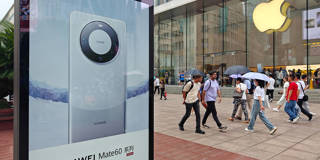STEPHEN S. ROACH

NEW HAVEN – The debate over the difference between tactics and strategy is as rich as it is enduring. In his seminal 1996 article in the Harvard Business Review, Harvard’s Michael Porter tackled this issue head on. While his focus was business, his arguments can be applied much more broadly – including to today’s Sino-American rivalry.
Porter differentiated between “operational effectiveness” and strategy, arguing that nimble companies had become well practiced in the former, but had dropped the ball on the latter. He also drew a sharp contrast between tactical tools – such as benchmarking, re-engineering, and total quality management – and competitive strategies aimed at “choosing a different set of activities to deliver a unique mix of value.”
Roughly 2,500 years earlier, Chinese military strategist Sun Tzu offered an equally profound perspective. In The Art of War, Sun wrote, “Strategy without tactics is the slowest route to victory,” stressing the complementarity of these two aspects of military decision-making. But Sun also counseled, “Tactics without strategy is the noise before defeat” – an admonition not to fixate on short-termism.
Notwithstanding Porter’s role in shaping the modern debate about strategy, today’s American body politic has little patience for long-term thinking. This was not always the case. George Kennan, first as a diplomat and later as an academic, devised the containment strategy that the United States used against the Soviet Union during the Cold War. Andrew Marshall, as the head of the Pentagon’s Office of Net Assessment, pushed the envelope on US military strategy. And Henry Kissinger, of course, was the ultimate practitioner of what has been dubbed “Grand Strategy.”
But these were exceptions, not the rule. Ever since former US President George H.W. Bush famously mocked “the vision thing” ahead of the 1988 presidential campaign, strategy has been held in low regard in Washington. The real-time feedback of ever fickle focus-group polling has become the North Star of US policy decisions.
That is especially the case in the Sino-American conflict, which over the last five years has morphed from a trade war to a tech war to the early stages of a new cold war. The US Trade Representative’s Section 301 report, published in March 2018, framed America’s tactical approach to its Chinese adversary, hinting at the tough actions that were soon to come.
This stands in stark contrast to China’s more strategic approach, exemplified by its five-year plans and longer-term industrial-policy initiatives, such as the controversial Made in China 2025 program, the Internet Plus Action Plan, and the New Generation Artificial Intelligence Development Plan. Like them or not, these goal-oriented initiatives come complete with metrics aimed at defining a trajectory from point A to point B.
The US, however, has focused more on penalizing China for defying the rules and norms of the global system – holding China accountable, for example, for violating the terms of its WTO accession in late 2001. This has taken the form of tariffs and sanctions – unilaterally imposed by the US – which were quickly followed by tit-for-tat retaliation from China.
From the start of the trade war in mid-2018, it has been American tactics vs. Chinese strategy. This mismatch has important consequences, not least for the so-called “phone war,” the new front in the Sino-American tech conflict. The opening salvo came this past August, when Huawei, China’s leading technology company, took the US by surprise with the release of its new Mate 60 Pro smartphone. The launch was undoubtedly timed to coincide with US Commerce Secretary Gina Raimondo’s visit to Beijing.
A TechInsights teardown commissioned by Bloomberg News revealed that the new Chinese smartphone is powered by a seven-nanometer Kirin 9000s chip fabricated by SMIC, China’s leading semiconductor manufacturer. While it still lags behind Apple’s new iPhone 15, which runs on a three-nanometer chip, Huawei’s breakthrough shocked sanctions-focused American officials by offering an indigenous product with 5G-like capabilities.
This is what happens in a conflict where one side is focused on tactics and the other on strategy. It should come as no surprise that Huawei has responded strategically to America’s aggressive tactical campaign to restrict its core businesses and supply-chain dependencies. When the US Commerce Department first put Huawei on the entity list for export controls in 2019 – striking a severe blow to the company’s once dominant smartphone – it forced the hand of China’s most R&D-intensive enterprise. Porter couldn’t have asked for more.
America’s tactical approach to the Chinese tech sector has been directed at the country’s military-civil fusion; the intent is to prevent the application of dual-use technologies to the production of weapons. Both Raimondo and National Security Adviser Jake Sullivan have warned that the US may use this same lens to assess the new Mate 60 Pro. That means the US could also be taking dead aim at China’s ultimate consumer-information appliance, with potential adverse implications for the consumer-led strain of Chinese growth that most Western economists, myself included, have long favored.
But China is not without clout in the phone war. Under the dubious guise of security concerns, it has started to restrict iPhone purchases by government officials, and there are hints that it might broaden the ban to include workers at state-owned enterprises. This is hardly inconsequential for America’s most valuable company, given that the Chinese market accounts for nearly 20% of Apple’s total global revenue. The biggest risk of all: Apple’s reliance on China as its main production and assembly base, despite early attempts to move operations to India and Vietnam.
In the end, it’s hard to argue with either Porter or Sun. Tactics are not enough to compensate for a lack of strategic thinking. Just ask Huawei and the world’s largest smartphone market. And try telling that to Washington.
No comments:
Post a Comment